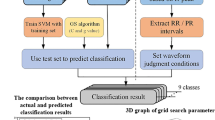Summary
During last 16 years we have successfully developed the computer-assisted vectorcardiogram analysis systems: model TJ-I. TJ-I, and TJ-I, but some technical problems remained unresolved, such as the recognition accuracy for vectorcardiograms, measurement of the parameters of complicated QRS waves, the ratio of T loop length to width, and the area of spatial vectors etc. A new system, model TJ-IV was designed to resolve these technical problems. The system was equipped with a 586 computer with a CPU of 120 MHz. Special new low-noise amplifier was employed and C language was used for programming. Three graph recognition techniques were used to enhance the accuracy of VCG recognition. 32 orthogonal electrocardiograms and vectorcardiograms were displayed and printed, and 566 parameters of vectorcardiograms were calculated. Our results with 150 cases showed that the system had high accuracy of graph recognition, and parameter calculation and the results were essentially consistent with those of manipulative methods. We were led to concluded when compared with TJ-I system, the new version has higher accuracy of processing and measurement for vectorcardiograms, is able to process more vectorcardiographic parameters, with higher processing speed.
Similar content being viewed by others
References
1987, 67:483
TJ-I 1995, 6(1): 8
Astrom M, Carro Santos E. Vectorcardiographic loop alignment and the measurement of morphologic beat-to-beat variability in noisy signals. IEEE Trans Biomed Eng, 2000, 47(4): 497
Frank ECG VCG,1997,7: 4
1989, 28(1): 10
Jensen J, Eriksson S V, Lindvall Bet al. On-line vectorcardiography during elective coronary angioplasty indicates procedure-related myocardial infarction. Coron Artery Dis, 2000, 11(2): 161
Watanabe Y, Wang J, Kondo Tet al. Vectorcardiographic evaluation of myocardial infarct size: departure parameters are superior to conventional spatial parameters. Jpn Circ J, 1998, 62(7): 473
Sawada K, Hirai M, Hayashi Het al. Spatial ventricular gradient in patients with Wolff-Parkinson-White syndrome in comparison with normal subjects: vectorcardiographic evidence for significant repolarization changes due to preexcitation. Intern Med, 1995, 34(8): 738
Bernadic M, Hatala R, Kaltenbrunner Wet al. Location of atrial and ventricular insertions of accessory atrioventricular pathways using surface ECG mapping and its importance in catheter ablation therapy. Bratisl Lek Listy, 1995, 96(4): 210
Frank,1989, 17(2): 143
Author information
Authors and Affiliations
Additional information
This project was supported by Wuhan Chenguang Program.
Rights and permissions
About this article
Cite this article
Xiaomei, G., Xianghong, J., Yanfei, R. et al. Model TJ-IV computer-assisted vectorcardiogram analysis system. Current Medical Science 21, 21–22 (2001). https://doi.org/10.1007/BF02888027
Received:
Published:
Issue Date:
DOI: https://doi.org/10.1007/BF02888027




